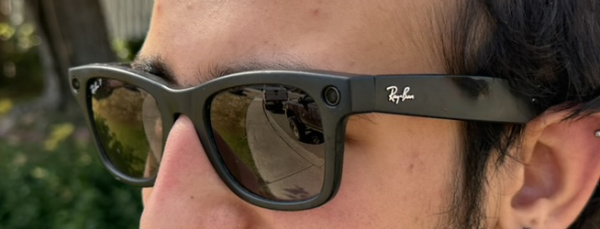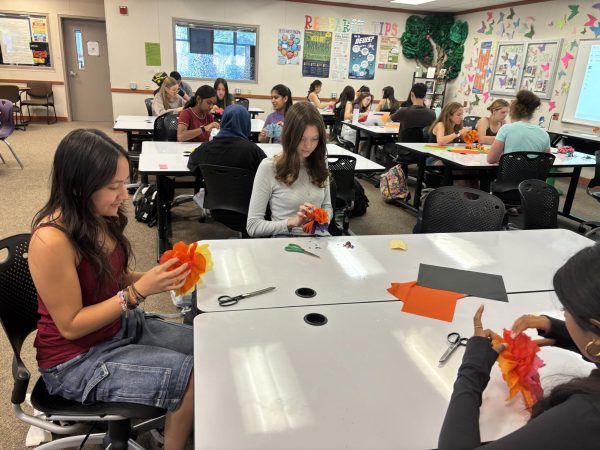Students vote on library additions with budgeting program

Senior Nicholas Harvey, left, and librarian Jessica Bailey review student budgeting votes.
Cal High’s library will be receiving upgrades, including a chair with a charging outlet and a seed library, after students voted last month on how the school should spend $1,300 in library funds.
Students initially submitted ideas for items the library could purchase and then voted on which proposals were best in the second stage.
After the 271 students voted from March 23-30, the winning proposals and their cost distribution included the following: a chair with a charging outlet for $650; archival boxes to preserve copies of student publications such as The Californian and The Protagonist for $190; four new locks for Makerspace boxes for $80; a class set of 10 copies of the book “Illuminae” for $200; a seed library for $120; a collection of student-written books for $30; and a copy of the book “Road to Wigan Pier” for $30.
The seed library wil feature a small cabinet containing California native plant seeds. Although students voted to not include any seeds in the seed library, they will be able to recover seeds from grown plants to be added.
Most of the items purchased were set to arrive on April 21, though the chair and seed library will take longer, librarian Nikki Ogden said.
“Just for me to have a voice, to be able to share my ideas, really allowed me to [share my voice] in the first place and be able to get my voice heard,” said junior Benjamin Lewis, who submitted a proposal idea and later voted.
The Student Senate, which is the San Ramon Valley Unified School District’s advisory board of secondary students, was involved in implementing participatory budgeting in the library for the first time.
“There [are] three representatives from each high school, and they all talk about what’s going on in our respective school, and we talk about ways we can fix what’s going on,” sophomore Elena Patro, a Student Senate member representing Cal, said.
Senior Nicholas Harvey, who is one of the Student Senate members and editor in chief of The Californian, initially presented his idea for participatory budgeting at a Site Council meeting.
The Site Council is a group of parents, students, admin, and staff who meet monthly to discuss ideas to improve the school.
Ogden was present at this meeting and instantly gravitated toward the idea. She said she wanted to try participatory budgeting on a smaller scale with the library budget.
“I thought it was genius, and for a long time I’ve been wanting to find ways to incorporate more student voice in the library,” Ogden said.
With the initial support to implement participatory budgeting, the money wasn’t hard to come by.
“A couple of months ago we found out that we have a surplus of $13,000 [in the library budget],” junior Simi Shetty, another member of the Site Council, said.
After Ogden agreed to the project, Harvey proposed to use 10 percent of the library’s budget, or $1,300. This money primarily came from registration donations, Ogden said.
During the planning process, the Student Senate decided to use the Stanford Crowdsourced Democracy Team’s participatory budgeting platform for the online ballot.
Since the library has numerous competing needs for upgrades, the participatory budgeting program let the library pinpoint what was most important to students.
Students first submitted a budgeting proposal about their ideas for the library before the voting occurred. The proposals were then reviewed and approved if they were financially viable and primarily benefited Cal students, amongst other rules.
Some proposals weren’t approved, such as junior Paul Iancu’s proposal for a mural depicting the history of San Ramon.
Once the items were finalized, Cal students received the URL for the online ballot through email or QR code. During voting, students could allocate different amounts of money to each item to buy different quantities until they reached the target of $1,300.
“On the website, you would select which [item] you wanted, and then you could actually select multiple [items], as long as it was within the $1,300 budget,” said Iancu, who voted. “It was super easy. [The budget] had really clear images for each one of the options.”
The most popular option was a charging chair, which received 218 votes.
“I voted for the chairs with the charging outlets […] and the books by students at Cal,” said sophomore Aarav Manjunath.
Annalise Wedewer, an eighth grader representing Pine Valley Middle School on the Student Senate, said the senate wants to expand participatory budget to other schools if proven successful at Cal.
“The idea was to start small and then probably expand to other high schools and then maybe see how it works at the middle school level as well,” Wedewer said.
With Cal being the first school in the district to implement participatory budgeting, the senate hopes to use this initial trial to expand to more schools.

Senior Abhinav Purohit is back for year three as the Social Media & Video Production Editor for The Californian. This year he hopes to strengthen the...




